

Updated January 2, 2025
Are you overwhelmed by social media marketing? Is all the talk of clicks, tweets, and engagement making you want to scream?
For small businesses, social media increasingly is a vital endeavor. Yet, wading through all the headlines and how-to guides can seem like an insurmountable task.
Looking for a Social Media Marketing agency?
Compare our list of top Social Media Marketing companies near you
Instead, Clutch is here with data-driven findings and tips to help small- to medium-sized businesses increase their social media prowess.
We conducted a survey of 350 small business owners/managers across the United States to determine digital marketing habits and goals for 2017. The survey’s respondents included 40% of companies with 10 or fewer employees, 27% with 11-50 employees, 25% with 51-250 employees, and 8% with 251-500 employees.
While concepts like “conversion funnels” and “geo-targeting” can help you further down the road, the following data points clarify five questions that are key to gaining a first foothold on social media.
Use the downward pointing arrows to navigate to a particular question from the list above.
What’s the most basic piece of advice regarding social media marketing? It’s to actually be on social media.
We found that almost one-quarter of small businesses surveyed do not yet use social media for their business, and 8% are unlikely to ever use it in the future.
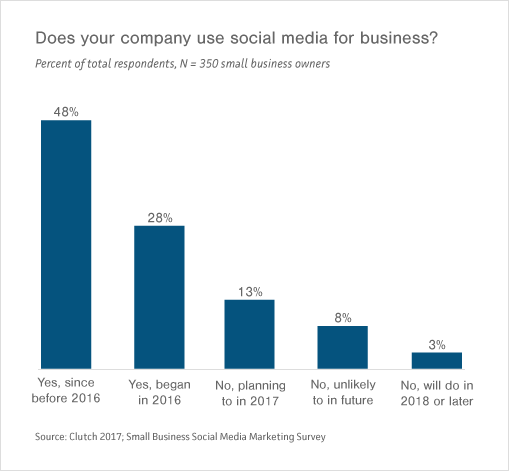
There are three key reasons why small businesses need social media: its cost effectiveness, growing popularity, and ability to target customers.
First, while every business’s marketing needs differ, an active social media presence has the potential to drastically improve your marketing abilities at a much lower cost than traditional media, according to Joshua Dirks, co-founder and CEO of Project Bionic, a Seattle-based creative marketing agency.
“I'm finding cost in social to be a fraction of what we'd normally see in the traditional marketing space,” Dirks said.
Second, social media is quickly replacing traditional media’s presence across many channels. Gaining traction now will only help your business as marketing inevitably shifts further and further toward social.
“Many [small business owners] read the headlines from five to six years ago about ‘likes’ not mattering and bought into that,” said Dirks. “They are missing out because of their own viewpoint on the topic, [made] from believing five- to six-year-old headlines and not recapturing the maturation of the space.”
Third, social media is particularly important if your business targets social media users – as most do, to some degree.
“If the target customer is on social media, the business should be too,” said Alex Oesterle, owner of Blue Bear Creative, a Denver-based social media agency. “It can give a brand emerging opportunities to become a part of customers' daily lives. With media consumption shifting from TV to mobile devices, it's almost a necessity.”
Social media provides valuable feedback about your customers, which can be used to improve the effectiveness of your marketing endeavors.
“Social is one of the few forms that allows you to look at the data,” said Keith Kakadia, Founder and CEO of Sociallyin, a Mississippi-based social media agency. “It allows you to determine whether there’s a return on investment (ROI) for the money spent. When you have a small budget, every single dollar needs to be spent on what works.”
Facebook is in a league of its own when it comes to social media. Over 90% of small businesses that have a social media presence use Facebook.

Do you only have the time or resources for one channel? Your best option is likely Facebook.
“In general, Facebook is a beast. Its reach is incredibly vast, with almost 2 billion users,” said Oesterle. “No matter what a business does, its customers are likely on Facebook, at least in part.”
Facebook’s advertising platform is incredibly powerful. It has the ability to target customers and provide feedback on a level not touched by most other marketing tools.
“You’re able to measure ROI directly,” said Kakadia. “If you’re an e-commerce business, you’re literally able to see the dollars spent and how much you’re making off that dollar. For small businesses, they’re able to see how many people are actually coming in.”
Over 50% of small businesses want to increase investment in Twitter, Instagram, and YouTube in 2017.

With these investment priorities in mind – Instagram, Twitter, and YouTube – how can a small business choose, especially if they don't have time for all three?
Given the uncertainty of Twitter’s future, it may not be beneficial for a small business to invest in it right now. Twitter recently shut down their micro-video sharing service, Vine and reported poor growth in 2016. “Twitter is having an identity crisis at the moment, but it's useful for brands that communicate with influencers and reporters,” said Dirks.
“Twitter is a wildcard in general,” said Oesterle. “It still has a huge active audience, but their recent shutdown of Vine is a bit of a red flag for me. I wouldn't recommend having a big investment in it; although it's still a great platform.”
As of December 2016, Instagram had over 600 million users and is growing rapidly. Instagram is an easy platform to dive into, given its built-in editing features and easy-to-use interface.
If you have the option to expand to a second social media channel, explore Instagram. “For someone looking to reach a younger market, Instagram is a good place to be,” said Dirks.
Lastly, YouTube users include up to a third of the world’s Internet users.
While YouTube can reap great rewards, it’s also costly and time-intensive to craft well-made videos. If you have the time and money to invest in video, by all means, do so. For a cash- and time-strapped small business, however, it may not be worth it.
Your social media channels aren’t helping your business if they remain inactive day after day. Social media is only as good as the effort you put in and the content you put out.
Forty-one percent (41%) of small businesses share content and/or engage followers multiple times per day, while another 23% do so once per day.
However, there isn’t a single universal answer for how often you should be posting. Success differs based on the channel, your goals, and the type of content you publish.
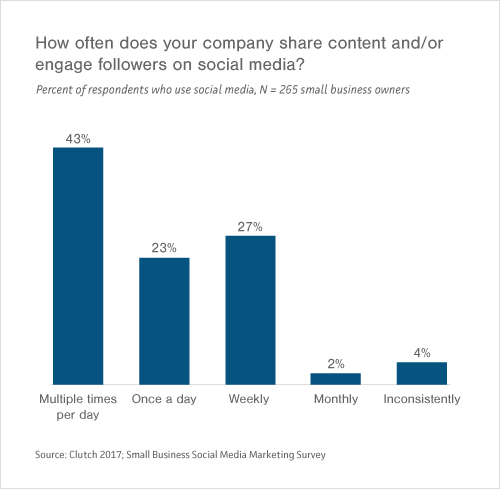
Oesterle of Blue Bear Creative recommends taking an analytical approach to sharing content on social media. “Our recommendation is to start out by testing posting frequency and gauging the effectiveness of the obtained engagement, as well as the type of response the company is getting from its followers and community,” he said.
Facebook posts can have a lifespan upwards of 24-48 hours, while a tweet’s half-life can be as small as 20 minutes, said Oesterle. Understanding how content lives on its particular channel is an important step toward understanding the channels’ different potentials. You can seek out recommendations on post frequency, but ultimately, it’s best for you to test what works well for you.
Start with commonly published advice – Oesterle recommends posting 1-2x per day on Facebook and several times per day on Twitter, for example, and then adjust based on results.
Now that you’re investing time in social media, it’s important to measure the rewards of your work. Clicks to website and audience growth are the two most popular metrics for small businesses to measure, tying at 25% each.
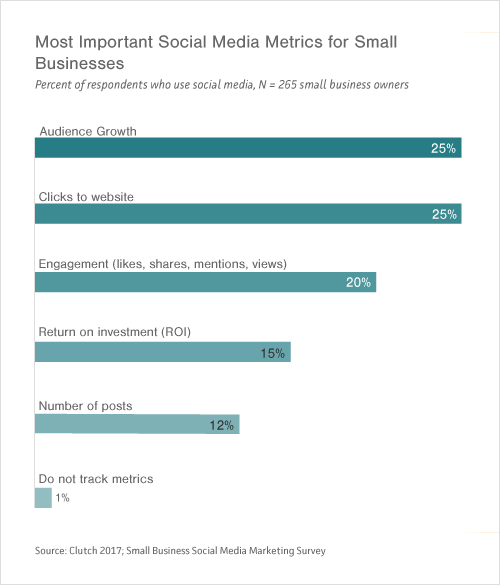
However, these metrics may not be the best fit for your small business, though they are a good place to start.
Choosing which metrics to track is similar to determining how frequently to share content. Determining the best metrics to track ultimately depends on your company’s individual goals. “I think the metric…you should be looking at is based on the objective,” said Kakadia.
Interestingly, when comparing the metrics small businesses track to the number of employees they have, we found that businesses with 51-500 employees place significantly more emphasis on audience growth than businesses with 1-50 employees.
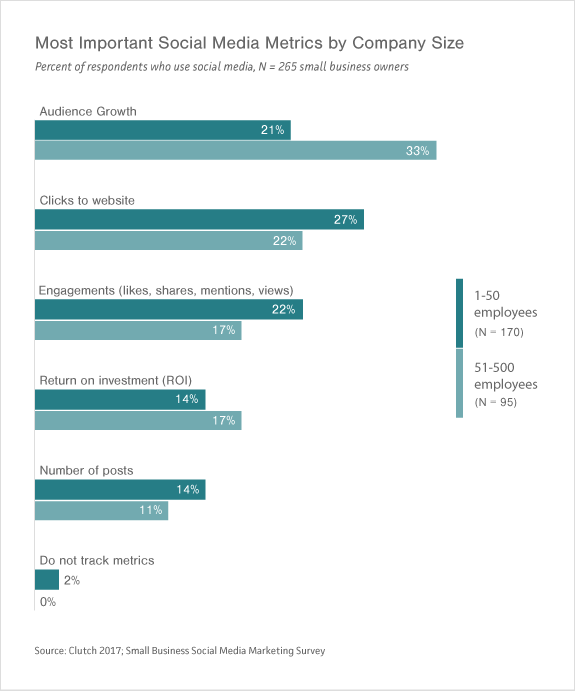
Audience growth is a demanding metric. “Medium-sized businesses have a little more rope, budget, and security in being able to go through and create larger social audiences,” said Dirks about the difference.
With all metrics though, it’s important to maintain a realistic mindset. “Many businesses jump into social media expecting to see an overnight increase in sales,” said Oesterle. “They are trying to achieve their own goals before providing any value to their followers or building a sense of community, which results in these companies falling flat.”
Instead, Oesterle emphasized the importance of measuring and improving metrics that lead to sales in the mid-to-long term.
Still feeling overwhelmed by social media? There are numerous resources available to help you. While over 50% of small businesses keep their social media marketing in-house, a significant amount – about one-third – also use freelancers or social media marketing software to help them in their work.
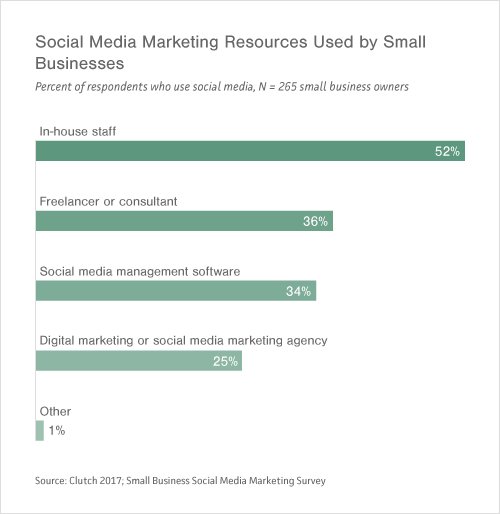
Staying in-house can be a good fit for many businesses, as long as they choose well-informed people. “One thing we hate to see is handing social media off to an intern or a freelancer with no knowledge of branding or strategy,” said Oesterle. “It makes for lackluster results and perpetuates the cycle of cutting social media costs.”
Dirks spoke similarly: “If someone is thinking about an internal team, they have to ensure that those people have the ability, know-how, and skills. Just because they're 25 and have iPhones doesn't mean that they have the requirements [to run social media].”
As businesses grow, they may come to a point where they need a team of experts to truly take their social media to the next level. This is when they should reach out to an agency.
“It's important for [the small business] to be at a point where they have a clear picture of their marketing goals and what they're looking to achieve from an agency. This will make life much easier for both the company and the agency,” said Oesterle.
Our survey results show fairly widespread adoption of social media marketing by small businesses, but there’s still room for growth. The future is on social, and it’s important to keep the following recommendations in mind to stay ahead.
Clutch surveyed 350 small business owners and managers to evaluate trends in marketing and advertising as part of its 2017 Small Business Digital Marketing Survey.
The small businesses surveyed have between 1-500 employees. 40% have fewer than 10 employees, while 46% have revenue under $1 million per year.
If you have any questions or feedback regarding these results, please contact Riley Panko at riley@clutch.co.


